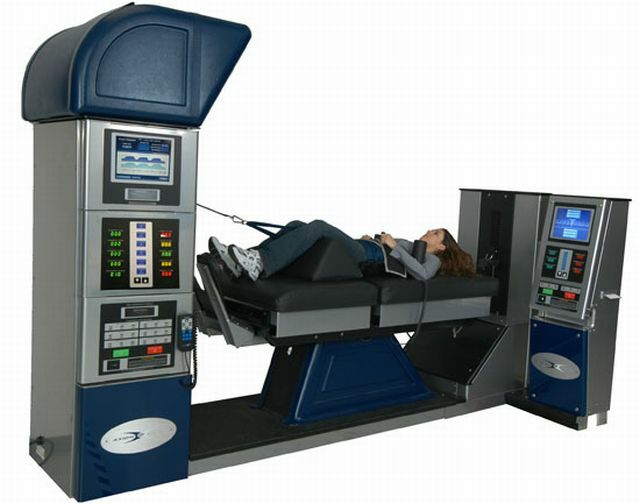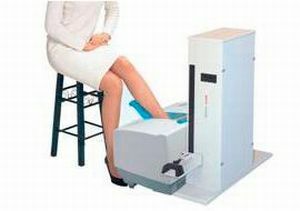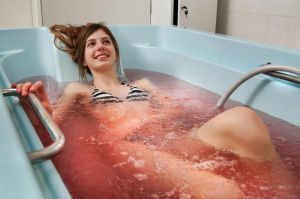 Manual therapy is one of the most effective methods of treatment of diseases of the musculoskeletal system.
Manual therapy is one of the most effective methods of treatment of diseases of the musculoskeletal system.
It not only improves blood circulation in tissues, but also restores the functions of vertebrae and intervertebral discs.
Manual procedures are successfully applied in many countries of the world and have been approved by most people suffering from spine diseases.
Contents of the article
- What is manual therapy?
- Features of the procedure
- Therapy for hernia
- Procedures for osteochondrosis
- Therapy for hypermobility of the cervical department
- Self-use of the
- procedure The people's voice
- Contraindications and cautions
What is manual therapy?
Manual therapy of the spine is a system of manual techniques that are aimed at activating all body forces to self-healing.
In cases of spine diseases, the main goal of treatment is the rehabilitation of intervertebral discs and vertebrae.
This is done with the help of special techniques, the essence of which consists in the removal of the articular surfaces from each other.
Thanks to the work of manual therapists( vertebrologists), affecting strictly certain areas of the spine, blood circulation in tissues improves, muscle tone rises, degenerative changes in intervertebral discs stop.
In addition, tactile influences activate the work of nerve endings and relieve muscle spasms. If manual procedures alternate with courses of physiotherapeutic procedures and reflexotherapy, the effect of treatment is increased several times.
Features of the
procedure As a rule, the vertebrologist is treated with the following complaints:
- permanent low back pain, which is accompanied by painful pain in the leg;
- limitation of motor function of the joints and spine;
- pain in the joints;

- numbness in the fingers or toes;
- attacks of sudden acute pain in the lumbar region;
- pain in the thoracic part of the spine;
- neck pain that is given to the head or arm;
- dizziness, tinnitus, impaired concentration and memory.
If these complaints are indeed a symptom of the pathology of the spine, the physician prescribes the treatment and practicability of manual therapy.
However, there are also those who, on the contrary, consider them necessary in the treatment. In fact, everything relies on the professionalism of the vertebrologist, since one wrong move can aggravate the course of the illness.
The presence of certain signs is not yet an occasion for the appointment of manual therapy. First, you need to confirm the diagnosis with radiography or MRI.
If the picture really shows pathology( intervertebral hernia, osteochondrosis and others), the doctor decides on the appointment of a treatment course.
Each physical procedure session lasts about 30 minutes .Then, for two days, a break is made to maintain the therapeutic effect.
Therapy for hernia
Many specialists do not undertake to do manual therapy with a hernia of the lumbar and cervical spine, as this work requires high professionalism.
However, this does not mean that it is contraindicated. In some cases, after the first session, the patient feels relieved.
In order for the exercises to have an effect and not to harm the body, the doctor must know the exact location of the hernia. As a rule, this disease uses decompression and shock-pulse technology.
The body of the patient is relaxed, so that the muscle tension and fixation of the body are equalized.
In the acute form of the disease, hands treatment is limited to light, plastic techniques. In this case, use the collar of Shantz or special orthopedic traction. 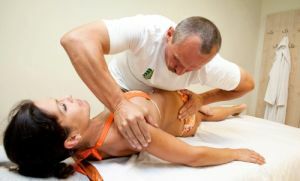
When the acute process begins to subside, postisometric muscle relaxation, traction mobilization is used.
Thanks to manual procedures in the body of the spine, negative pressure is created, and the hernia, according to the laws of physics, is injected back.
In addition, such exercises relieve pain and eliminate the main cause of the disease. This cause, in most cases, is the osteochondrosis of the spine.
How spinal chiropody is administered - video lessons:
Procedures for osteochondrosis
The essence of osteochondrosis is the curvature and destruction of the vertebrae, so the medical practice is aimed at restoring their functions.
Vertebrologists distinguish 4 phases of the disease:
- is secretive;
- is characterized by movements of the vertebrae and pain;
- develops an intervertebral hernia;
- spondylolisthesis is formed, in which the vertebrae are displaced and bone proliferation appears.
Treatment with hands is effective only in the first three stages. When there are sprouting of bone, it can not help.
Before the start of the session, the muscles are kneaded, and then slowly stretched. These procedures eliminate muscle spasms and improve local blood circulation.
Then proceed to the therapy itself, which has such components:
- mobilization;
- keying;
- therapeutic massage;
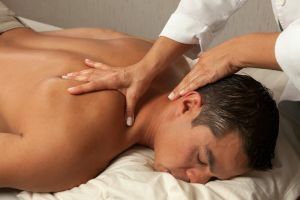
- automobilization;
- functional correction.
The most popular and most effective technique is massage. All exercises are done in such positions, in which you can maximally stretch the muscles in the area of exposure.
Before repeating the stretching, you need to gently move in the opposite direction, and then fix the muscles for a few minutes. Such approaches well relieve muscle spasms.
Therapy for hypermobility of the cervical part of the
One of the most common neck pathologies is hypermobility.
Manual therapy with instability of the cervical spine is aimed at its elimination.
For this, first of all, relieve muscle tension. When the load is removed from the diseased vertebra, it is less diluted and the disease does not progress.
The main method of therapeutic therapy for unstable cervical vertebrae is autoimmobilization.
Its essence is that the patient with one hand clasps his head and tilts it forward, and the other - propping his chin. Then he slowly wraps his head and makes a swing in the direction of rotation.
These procedures not only relieve tension, but also improve local blood circulation.
Self-use of the
method The use of manual therapy of the spine at home is possible only with the help of others.
For this purpose a physically strong, strong person who will have an understanding of the physiology of the body and is trained in the technique of medical procedures will be well suited.
Before starting the practice, it is necessary to warm up the muscles with a special vibro-massager, a warm bath or a segmental massage.
 This can be achieved by relying on the back of a chair or other surface, or by holding the vertebral sections with your hands. Most often, the method of supporting hands is used to treat the cervical or lumbar spine.
This can be achieved by relying on the back of a chair or other surface, or by holding the vertebral sections with your hands. Most often, the method of supporting hands is used to treat the cervical or lumbar spine.
Each movement should be done only with a slight push. Many exercises do not require the use of force at all, since they are arranged on the principle of inertial impact.
The therapeutic effect in this case is achieved due to the personal body weight. The most difficult to carry out procedures only in certain areas of the spine, without propelling or straining other muscles.
The voice of the people
What do people write in their reviews who have had manual procedures?
My neck has been troubling me for a long time: one vertebra is moving, the nervous endings and blood vessels. From time to time there are dizziness and severe headaches. On the advice of friends I went to the manual therapist.
He tortured me for an hour, but no effect. The headaches intensified even more. After that - I do not have a leg to the manual therapists.
Dasha, 36 years old
I started having problems with my spine in the 9th grade. Then the surgeon advised me to go swimming, to correct the curvature. Did not help.
I was up to 25 years with severe back pain, until I learned about manual therapy. After the procedures, I could not even walk - they were so painful. But two weeks later there was relief. It's been three months now since back pain does not bother you.
Artem, 25 years old
Constantly suffering pain in the cervical spine. After the examination, the doctor advised me to go to the manual therapist.
His procedures really helped, and for more than a year now I feel fine. The drawbacks are that exercises are rather painful, and therapy is not cheap.
Olga, 48 years old
Contraindications and cautions
Like any other type of treatment, manual therapy can harm health.
Therefore, it is important to know in which cases it is contraindicated. These include:
- acute joint disease;
- disc myelopathy;
- arthrosis of 3-4 degrees;
- osteoporosis of bones;
- injury of intervertebral discs;
- tumors of the spine, spinal cord or brain;
- Forestier's disease;
- consolidated fractures of the spine.
Regarding pregnancy, many experts are positive about the treatment with their hands. 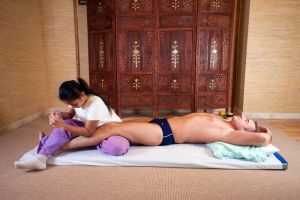
The fact is that during the period of carrying a child most drugs are contraindicated, and manual procedures can be a real rescue from pain.
It is not recommended to carry out therapy only if there is a threat of premature birth, abortion, or suspicion of placental abruption.
Given the feedback of patients and doctors, as well as numerous studies, it can be concluded that in the treatment of the spine, manual therapy is completely safe.
Moreover, it has an amazing effect, which can not always be achieved even with drug treatment.
Only an experienced, qualified specialist is able to cure the spine and at the same time not to harm the rest of the body.

